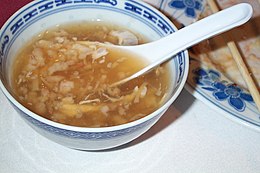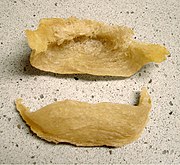Bird's nest soup
From Wikipedia, the free encyclopedia
| Bird's nest soup | |||
|---|---|---|---|
| Traditional Chinese | 燕窩 | ||
| Simplified Chinese | 燕窝 | ||
| Literal meaning: | swallow's nest | ||
| |||

Bird's nest soup is a delicacy[1] in Chinese cuisine. A few species of swift, the cave swifts, are renowned for building the saliva nests used to produce the unique texture of this soup.
The edible bird's nests are among the most expensive animal products consumed by humans. The nests have been traditionally used in Chinese cooking for over 400 years, most often as bird's nest soup.[2]
Contents[hide] |
[edit] Name
The Chinese name for bird's nest soup, yàn wō (燕窝), translates literally as "swiftlet nest". When dissolved in water, the birds' nests have a gelatinous texture used for soup or sweet tong sui. It is mostly referred to as "jin wo" unless references are made to the salty or sweet soup in Chinese cuisine.[citation needed]
[edit] Harvesting
The most heavily harvested nests are from the Edible-nest Swiftlet or White-nest Swiftlet (Aerodramus fuciphagus) and the Black-nest Swiftlet (Aerodramus maximus)[3]. The white nests and the “red blood” nests are supposedly rich in nutrients which are traditionally believed to provide health benefits, such as aiding digestion, raising libido, improving the voice, alleviating asthma, improving focus, and an overall benefit to the immune system.[2]
The nests are built during the breeding season by the male swiftlet over a period of 35 days. They take the shape of a shallow cup stuck to the cave wall. The nests are composed of interwoven strands of salivary laminae cement. Both nests have high levels of calcium, iron, potassium, and magnesium.[1]
Hong Kong and the United States are the largest importers of these nests.[4] In Hong Kong a bowl of Bird Nest Soup would cost $30 USD to $100 USD.[2][4] A kilogram of white nest can cost up to $2,000 USD, and a kilogram of “red blood” nest can cost up to $10,000 USD. The white nests are commonly treated with a red pigment, but methods have been developed to determine an adulterated nest.[5]
The nests were traditionally harvested from caves, principally the enormous limestone caves at Gomantong and Niah in Borneo. With the escalation in demand these sources have been supplanted since the late 1990s by purpose-built nesting houses, usually reinforced concrete structures following the design of the SE Asian shop-house ("ruko") These nesting houses are normally found in urban areas near the sea, since the birds have a propensity to flock in such places. This has become an extraordinary industry, mainly based on a series of towns in the Indonesian Province of North Sumatra which have been completely transformed by the activity. From there the nests are mostly exported to Hong Kong, which has become the centre of the world trade, though most of the final consumers are from mainland China. It has been estimated that the products now account for 0.5% of the Indonesian GDP, equivalent to about a quarter of the country's fishing industry.
[edit] Notes
- ^ a b Marcone, Massimo F. (2005) "Characterization of the edible bird's nest the Caviar of the East". Food Research International 38:1125-1134.
- ^ a b c Hobbs, Joseph J. (2004) "Problems in the harvest of edible birds’ nests in Sarawak and Sabah, Malaysian Borneo." Biodiversity and Conservation 13: 2209-2226.
- ^ Gausset, Quentin.(2004) "Chronicle of a Foreseeable Tragedy: Birds' Nests Management in the Niah Caves (Sarawak)." Human Ecology 32: 487-506.
- ^ a b "Bird-nest Soup, Anyone?" by Therese Park, Koreabridge Writings, 8 February 2005.
- ^ "Characterization of the edible bird’s nest the “Caviar of the East”" by Massimo F. Marcone, Food Research International, Volume 38, Issue 10, December 2005, Pages 1125-1134.
[edit] References
- Jordan, David, 2004,"Globalisation and Bird's Nest Soup" International Development Planning Review, Volume 26, Number 1, Liverpool University Press and http://www.jordanresearch.co.uk/pubs.html
- Lau, Amy S.M. and Melville, David S. (April 1994) International Trade in Swiftlet Nests with Special Reference to Hong Kong Traffic Network 35pp. ISBN 1-85850-030-3
- Bizarre Foods with Andrew Zimmern [imdb], (A Travel Channel Show) featured a segment on Bird's Nest Soup in the Asia episode. (1 November 2006 (Season 1, Episode 0)
- The Bamboo Climbers http://www.upndownfilms.tv/films.htm from Upndown Films follows a British Climber as he meets and climbs with the Birds Nest collectors on Laoliang, an Island in the Andaman Sea.



